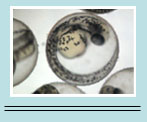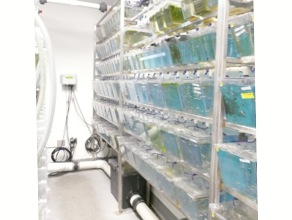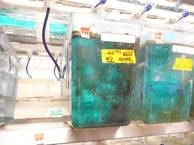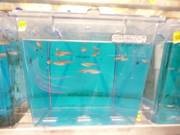

Home
Common Techniques
Classroom Experiments
Virtual Experiments
Tutorials
Games
Glossary
Links
Publishing
Opportunities
About This Site
Contact Us
ZFIN
Cite Us
How to maintain a zebrafish laboratory
Due to the fact that zebrafish laboratories are difficult to set up, a company should be hired. Numerous details should be kept in mind when maintaining a zebrafish laboratory so the fish can live relatively long lives. As recommended by the Aquatic Habitats® manual, maintenance should be done only on the recirculating system. Also, chemicals or cleaning agents should NEVER be used to clean the fish room.

The room temperature should be kept at 76 degrees Fahrenheit and the water temperature should be kept at 82 degrees Fahrenheit. The light for the room should be on for 14 hours and the room should be dark for 10 hours.
All caretakers of the zebrafish laboratory should check the following daily:
1. Aquarium covers should be on tight.
2. Aquarium down spouts should be dripping into the tank.
3. Aquarium water should be running.
4. Inspect for any signs of leaks.
5. Doors to the facility should be closed at all times to maintain the room temperature.
6. A daily check of Nitrite on the Quarantine Rack should be done with the Nitrite Kit provided in the lab. Record readings on the Maintenance sheet provided in the fish room.
Room cleaning
The floor should be mopped once a week and whenever there is a spill of water. Every two months, the floor should be cleaned more thoroughly with warm water and brushes; the surfaces in the fish facility should be wiped down to remove any accumulated dust and debris.
Tank changing
Adult fish: Tanks should be changed whenever the fish cannot be easily seen through the front of the tank due to algae build-up. The identification tags should first be moved to the new tank, which should be filled at least half full with system water. The fish should then be netted into the new tank, which replaces the old on the rack.
Baby fish: Zebrafish are not mature until they are 3 months old. Because they are small, netting baby fish can cause serious injury and even death. Therefore, they must be kept in the same tank for 2-3 months. This can cause algae build-up that makes it difficult to see into the front of the tank. Therefore, the baby fish should be checked through the lid of the tank. A white tag placed on the front of the tank specifies the correct amount of food needed.
Tank cleaning
Dirty tanks should first be scrubbed with a stiff brush to remove the majority of the algae. They are then placed in a dilute bleach solution for 4-24 hours or washed by hand, and then stacked until they are thoroughly dry.
 |
 |
Dirty Tank |
Clean Tank |
Fish Identification
All fish in the facility are labeled with the stock number, date of birth, the number of fish within the stock, and who is in charge. One should be mindful of this information and careful when putting fish into tanks. When setting up fish to breed, record stock name, tank and rack that the fish came from on the breeding chart. An individual fish can only be bred once per week.
Euthanasia
If a fish is visibly sick, (lethargic, skinny, open wounds) it should be removed and euthanized. Record this information on the Fish Information sheets provided within the fish facility. To euthanize, put the fish system water into a large beaker or 2.75 L tank and add ice to make an ice-water bath. Net fish to be euthanized into one of the inserts to the crossing cages, and lower this into the ice water bath. Do not allow the fish to come into contact with the ice. Leave for 15-20 minutes, until the fish are dead and dispose of carcasses as described below.
Waste Disposal
Any dead fish found in a tank should be removed immediately. Rinse off a net with tap water thoroughly before using in a tank. The fish carcass should then be wrapped in a paper towel and put into the biohazard bag in the freezer until removal to the post-mortem room at the Animal Resource Center.